Board Game – Term 01
Posted by Matheus Pitillo on Feb 25, 2012 in Life at VFS | 12 comments
Hey guys! Term 01 is finally over and now we are having 4 days of school break until next Monday. As I already said some posts before, one of our final projects for Term 01 – and by the way one of the most important on this term – was the Board Game for Game Theory (Analog) Class. So here I am to present how was each one of the steps to finally have the final game in hands.  First of all, I need to thanks and congrats my friend Mustafa Dungarpurwala who did the game with me as a team.
First of all, I need to thanks and congrats my friend Mustafa Dungarpurwala who did the game with me as a team.
In the beginning of the first month in Game Theory (Analog) Class, we received an assignment which we were supposed to create 25 to 50 Board Game ideas. This assignment was great to show to us what was our experience with board games. Mustafa and I decided to take all of our ideas together and between almost 100 different concepts we tried to find the one which received the best feedback from Gregory MacMartin, our teacher. The funniest part was how we transformed a simple game concept into an intelligent and unique one. From a thief who should escape a police officer who walks in the board every two rounds, to recover the stolen money, into a adventure game with Dragons and Magics. And this is how Dragon’s Burrow was born.
Dragon’s Burrow
The background story of Dragon’s Burrow is about win the right to have the love of the princess. To be worthy to marry Princess Celina, The King of Armana has thrown a challenge to the four different contestants: Elf, Orc, Gnome and Human. The one who gets the maximum number of eggs from the Dragon’s Burrow wins the challenge. But the big question is: The Dragon will let them do that?
From the first concept to the last one, we had a lot of changes to turn the gameplay more interesting. When we are developing a board game, the most important thing is the feedback from the players. We will only be able to make the game better if we receive and accept opinions by others. In our class it was required at least 5 playtests with different people.
Basically our gameplay works as follows: In a total of five players, each one must choose one of five races – Orc, Elf, Gnome, Human and Dragon – to play. The criterion of choice of the order follows the answer to the question: “Who ate eggs recently?”. The player who has recently eaten eggs is the first to choose a race and play the game. And for the others following clockwise sequence order.
The four adventures has the objective to capture as many eggs that they can, and bring it back to their respective hideouts. While, the objective of the Dragon is to defend her eggs to be captured, killing the adventurers. If an adventurer with an egg on his hands is killed, the Dragon needs to get the egg and drop it back in one of the nests in the second floor. Saving the captured egg will add a score to the Dragon. When Dragon reaches 4 scores the game ends and she wins. But if adventurers captures more eggs, before the Dragon save it again, the adventurers wins according to the number of eggs they have in their hideout.
We decided to give one Specific Racial Ability for each Race in the game. The hardest part was to balance everything. Also, in addition to the Racial Ability, adventurers can chose one of the three Special Skills that they can use during the game.
For the movement, we decided to use a different method to move the players around the board. We did not want to use dices, then we create Movement Cards following the pattern of the game Tetris. Players need to use a card and walk according to the certain number of tiles available, and following exactly the same direction of the cards. In the beginning of player’s turn, they need to draw a new card, being able to chose one card of three. They also have the option to discard a single card to move just one tile in the board.
And finally, we decided to add Treasure Cards to give to players some kind of good rewards and, sometimes, bad events. And also some tunnels that able players to cross from one side to the other of the board.
First Prototype
The game started with a very simple concept in which players walk around the board on a single floor. Upon leaving the bridge where they began their match, players had to go ahead, grab the egg and return to their hideout.
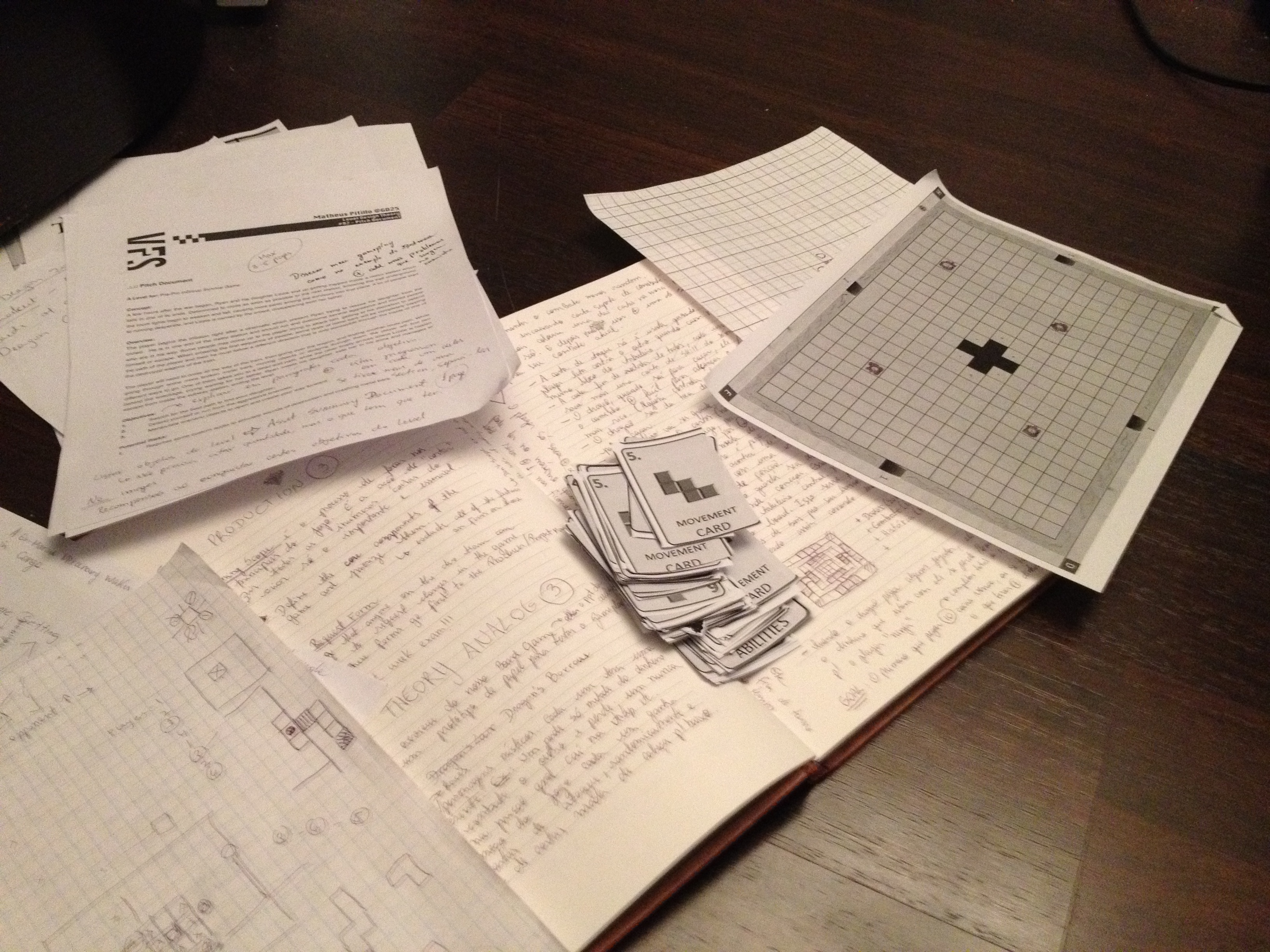
In our first match, the game was tested on a paper prototype. The cards were not yet very well balanced and the fact we only have a single floor in the game, made the Dragon had an incredible advantage against the adventurers.
Second Prototype
After some playtests with our friends at school, me and Mustafa were searching for some solution to balance the Dragon strength. And then a great idea appeared in our heads. What if we create two different floors, with different kinds of access? This way, and adding some blocked stones in the board, we could manage very well the distance between Dragon and Adventurers, making the game very well balanced. For our second prototype, we also used paper, but now with more details and the second floor option.
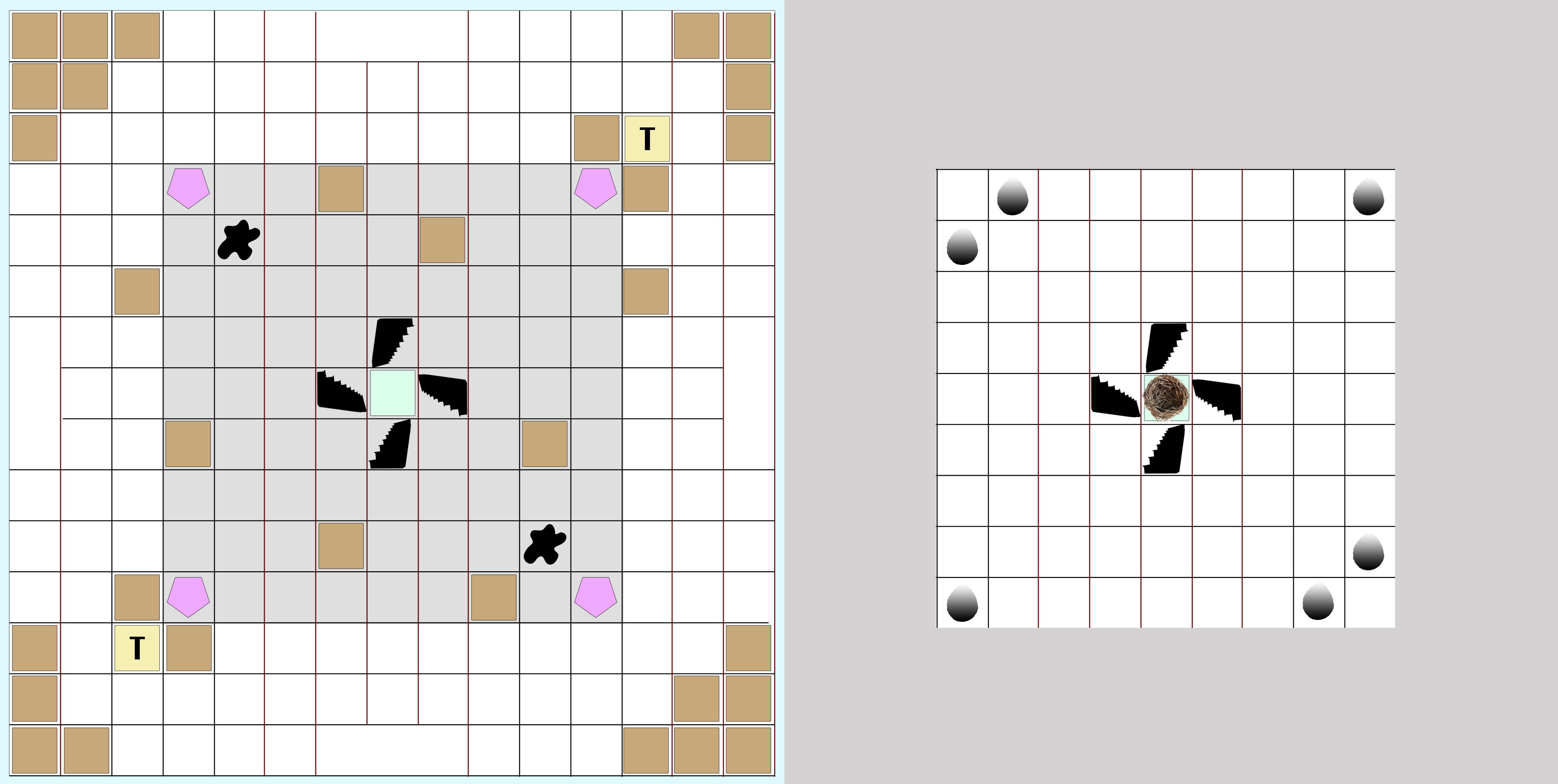
More playtests, and we still needed to balance the gameplay in some aspects. Players who were playing as the Adventurers were not satisfied with the fact that when the Dragon capture and save an egg again, the players had no more chance to capture it again. From that point we decided that when the Dragon adds one more point to her score, the egg does not disappear from the board. Thus, adventurous can try to catch it again, provided they can steal all the eggs before the Dragon complete four of them.
Third Prototype
Almost the same as the final design of the game, the third prototype we created in paper too, but now with colours, cool images and cards. In this last prototype we solved a lot of mistakes that we were having before. Other interesting things we added were the features of the pieces of the game itself. We bought magnetic pins that could represent each race of the game. While the eggs were magnet too, when the player approaches the egg, your character will automatically stick to the magnetic egg. This way players can control only the pin as it moves across the board, carrying the Dragon egg too.
* The whole art of the game was made through the combinations of images found on Google. Although we have edited and changed all the illustrations, we do not have the copyrights of the images. This is a nonprofit project containing images and references taken from Google.
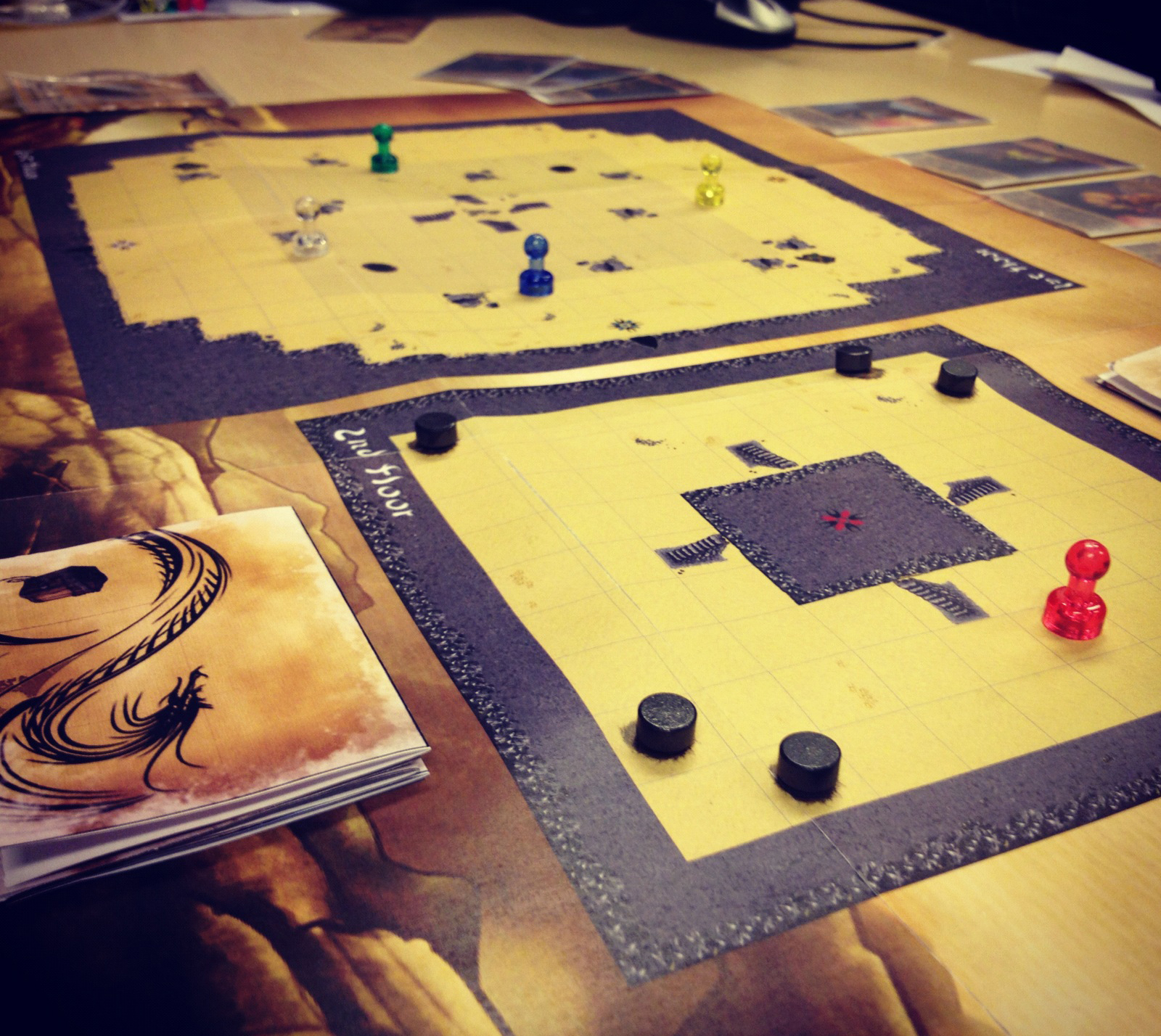
With our third prototype we and our friends presented the games in class, in one of the last weeks of Term 01. And after that, finally creating the final version of the Board Game, with the Rule Book and Playtesting Reports.
Board Game Presentations
We had a full afternoon of presentations that began at 4h00pm and ended at 10h00pm. During the presentations, the teacher evaluated mostly the game concepts, game mechanics, gameplay, design, and finally if the games fit in Garneau’s Forms of Fun, and in which classifications of Roger Caillois the games were also present.
Between the 14 forms of classifiable fun, Dragon’s Burrow embody mostly the Immersion, Intellectual Problem Solving, Competition, Social Interaction and Advancement. These forms can be combined perfectly in game. Also, talking about Roger Caillois Analysis, he would classify our board game as a mix of Alea and Agon.
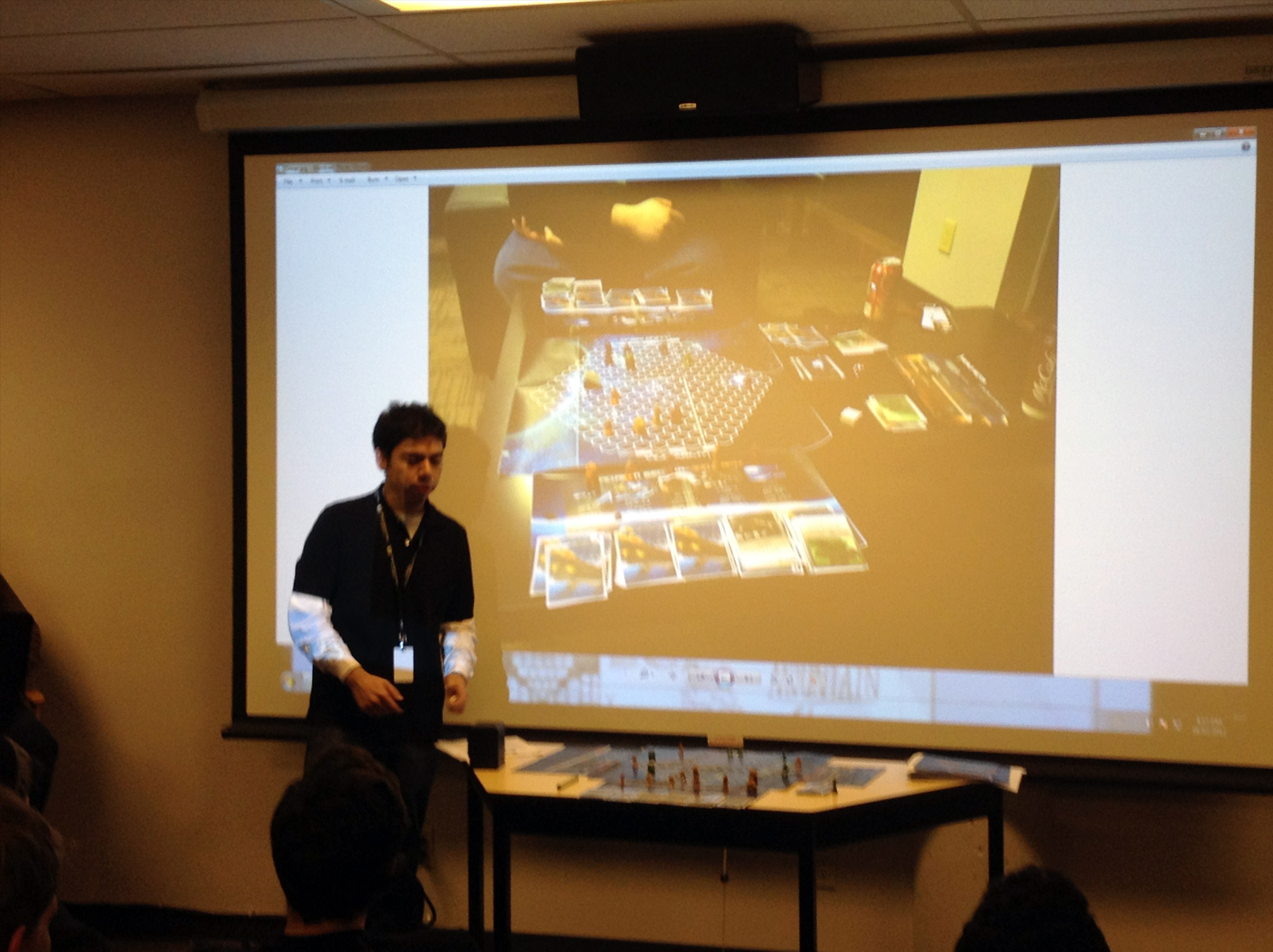
Omar Gonzalez presenting his game Hadrium Sector
The presentations were very well and I confess that I felt good when I was presenting the game to the rest of the class this time. I believe that Mustafa also felt comfortable. 
Playtesting Reports
As I already said above, we went through five different playtests to get the results we had.From this we created a document to present this evolution and the feedback received. After the presentation in class with our game prototype, we received a lot of good feedbacks also. Between all student’s tips, we decided to create a kind of co-op gameplay between players, in which they can protect themselves against the dragon, creating a range of defense. The problem was the Dragon was already balanced in the last time that we’ve play tested. Adding the co-op gameplay the Dragon started to be too weak, so we decided to focus in the old gameplay and just make the rules even more balanced and specific.

During all the process of development of our game we passed through various different board layouts. We finally decided to have a two floor board when we noticed that this way we could create a better design for the game and also use it in our favor, by manipulating the balance of the game between the floors. From a very simple map, we did a better one with cool colors, textures, props and conditions. All cards and pins were updated too, to create the best design.
Final Version
And finally, we made the final version of the game, printing the image on a board. Next to VFS there is a store that does these printing on the board. Almost all students of the course chosen by their service. For the final delivery we did the Rule Book and Playtest Document. We put everything in a box, along with the pins and the cards and we delivered to the teacher.

The most interesting part of this whole project is to analyze how much we have learned during these two months. From very simple rules, we have transformed and reached most intelligent and balanced rules. I did not expect to make something so interesting in so little time. And again the school surprised me in the right direction.
That’s all folks! I’m trying to figure out some way to post all I have in mind. But as always, time is short. I’ll try harder. Thanks!
acompanhe esse texto em português
Eaí pessoal! O term 01 finalmente acabou e agora nós estamos tendo quatro dias de intervalo até a próxima Segunda-Feira. Como eu já disse há alguns posts, um dos nossos projetos finais do term 01 – e que por sinal talvez seja um dos mais importantes desse term – foi o jogo de tabuleiro para a aula de Game Theory (Analog). Então aqui estou novamente para apresentar quais foram cada uma dessas etapas para finalmente ter o jogo em mãos. Mas antes de tudo eu quero agradecer e parabenizar o meu parceiro Mustafa Dungarpurwala, que fez parte do time comigo.
No início do primeiro mês na aula de Game Theory (Analog) nós recebemos um assignment no qual nós deveríamos criar de 25 a 50 idéias para jogos de tabuleiro. Esse assignment foi ótimo para nos mostrar qual era a nossa experiência com jogos de tabuleiro até então. Eu e Mustafa decidimos juntar todas as quase 100 idéias e escolher a que recebeu o melhor feedback da parte do nosso professor Gregory MacMartin. A parte mais interessante é como nós transformamos um simples conceito de jogo em um completamente novo, inteligente e único. De um jogo sobre um ladrão que deve escapar de um policial que circula ao redor do tabuleiro de dois em dois turnos, para recuperar o dinheiro roubado, em um jogo de aventura com Dragões e Magias. E dessa maneira foi como Dragon’s Burrow surgiu.
Dragon’s Burrow
A história de fundo de Dragon’s Burrow é sobre conquistar o direito de ter o amor de uma princesa. Para ser digno de se casar com a princesa Celina, o Rei de Armana lançou um desafio para os quatro diferentes competidores: Elfo, Orc, Gnomo e Humano. O competidor que conseguir o maior número de ovos de dragão de dentro da toca do Dragão, vence o desafio. Mas a grande pergunta é: o Dragão vai deixá-los fazer isso?
Do primeiro conceito ao último nós tivemos várias mudanças para tornar o gameplay mais interessante. Quando estamos desenvolvendo um jogo de tabuleiro a coisa mais importante é o feedback da parte dos jogadores. Nós só seremos capaz de deixar o jogo melhor se recebermos e aceitarmos opiniões dos outros. Na nossa classe foi exigido pelo menos 5 playtests com pessoas diferentes.
Basicamente o nosso gameplay funciona da seguinte maneira: em um total de cinco jogadores, cada um deve escolher uma das cinco raças – Orc, Elfo, Gnomo, Humano e Dragão – para jogar. O critério da escolha da ordem se segue com a resposta para a seguinte pergunta: “Quem de vocês comeu ovo recentemente?”. O jogador que tiver comido ovo mais recentemente é o primeiro a escolher a raça que quer controlar e o primeiro a jogar. E para os outros, deve seguir a sequência horária.
Os quatro aventureiros tem o objetivo de capturar a maior quantidade possível de ovos de dragão e trazer de volta para seus respectivos hideouts. Enquanto isso, o objetivo do Dragão é o de defender seus ovos e impedir que sejam capturados, matando os outros aventureiros. Se um aventureiro com um ovo em suas mãos for morto, o Dragão precisa pegar o ovo e trazer de volta para um dos ninhos no segundo andar. Salvando o ovo capturado irá dar uma pontuação adicional ao Dragão. Quando o Dragão completar 4 pontos o jogo se encerra e ele vence. Mas se os aventureiros capturarem mais ovos, antes que o Dragão os salve novamente, os aventureiros vencem de acordo com a quantidade de ovos que eles possuem em seus hideouts.
Nós decidimos criar uma Habilidade especial para cada Raça do jogo. A parte mais difícil foi balancear todas essas habilidades. Ainda, em adição a Habilidade da Raça, aventureiros podem escolher uma entre três opções de Habilidades especiais que eles podem usar durante o jogo.
Para o movimento, nós decidimos utilizar um método diferente para mover os jogadores pelo tabuleiro. Nós não queríamos usar dados, então criamos Cartas de Movimento seguindo o padrão de tiles do jogo Tetris. Jogadores precisam usar a carta e andar de acordo com o número de tiles disponíveis, e seguindo a direção exata mostrada na carta. No início do turno do jogador ele precisa comprar uma nova carta, estando sempre apto a escolher uma opção de movimento, dentro de três. Os jogadores também possuem a opção de descartar uma única carta, para mover apenas um tile pelo tabuleiro.
E finalmente, nós decidimos acrescentar Cartas de Tesouro para dar aos jogadores uma espécie de boas recompensas ou, em alguns casos, alguns eventos ruins como consequência. Alguns túneis também foram adicionados dando a opção do jogador se mover rapidamente de um lado para o outro do tabuleiro.
Primeiro Protótipo
O jogo começou com um conceito muito simples nos quais os jogadores precisam andar pelo tabuleiro em um único andar. Após sair da ponte na qual o jogo começava, os jogadores tinham que apenas seguir o seu caminho a frente, pegar um ovo e retornar para o seu hideout.
Na nossa primeira partida, o jogo foi testado em um protótipo de papel. As cartas ainda não estavam muito bem balanceadas e o fato de termos apenas um andar no jogo fazia com que o Dragão tivesse uma incrível vantagem contra os aventureiros.
Segundo Protótipo
Após alguns playtests com os nossos colegas de classe, eu e o Mustafa procuramos alguma solução que balanceasse a força do Dragão. E então uma incrível idéia veio em mente. E se nós criássemos dois andares diferentes, com diferentes posições de acesso? Dessa maneira, adicionando algumas pedras para bloquear alguns tiles do tabuleiro, nós poderíamos manejar melhor a distância entre o Dragão e os Aventureiros, fazendo o jogo se tornar mais balanceado. Para o nosso segundo protótipo nós também usamos papel, porém dessa vez com mais detalhes, cores e um segundo andar.
Mais alguns playtests depois e nós ainda precisávamos balancear ainda mais o gameplay em alguns aspectos. Os jogadores que estavam jogando como um dos aventureiros ainda não estavam satisfeitos com o fato de que o Dragão após capturar e salvar um ovo novamente, o aventureiro não teria mais chances de conquistar aquele específico ovo de novo. Dessa maneira decidimos que quando o Dragão soma mais um ponto para o seu placar, o ovo não desaparece do tabuleiro. Sendo assim os aventureiros podem tentar capturar aquele ovo de novo, desde que consigam roubar todos os ovos antes que o Dragão complete um total de quatro pontos.
Terceiro Protótipo
Quase o mesmo que o design final do jogo, o terceiro protótipo que criamos foi feito em papel também, mas agora com cores, imagens legais e cartas. Nesse último protótipo nós solucionamos diversos erros que estávamos tendo anteriormente. Outras coisas interessantes que adicionamos foram as próprias peças do jogo. Nós compramos pinos magnéticos para representar cada raça do jogo. Como os ovos também eram peças magnéticas, quando o jogador se aproxima do ovo ele automaticamente se gruda a ele. Assim, os jogadores podem controlar apenas o seu pino e carregar o ovo ao mesmo tempo pelo tabuleiro.
* Toda a arte do jogo foi feita através de combinações de imagens encontradas no Google. Mesmo que tenhamos editado e alterado todas as ilustrações, nós não possuímos os direitos autorais das mesmas. Dragon’s Burrow não é um projeto com fins lucrativos.
Com o nosso terceiro protótipo nós e nossos amigos apresentamos os jogos em classe, em uma das últimas semanas do Term 01. Depois de tudo isso, finalmente criamos a versão final do jogo, com o livro de regras e o Documento de Playtests.
Apresentações dos Jogos de Tabuleiro
Nós tivemos uma tarde cheia com apresentações que começaram as 16h00 e terminaram apenas as 22h00. Durante as apresentações o professor avaliou principalmente o conceito do jogo, a mecânica, gameplay, design e, finalmente, se os jogos se encaixavam nas formas de diversão de Garneau e, em quais classificações de Roger Caillois o jogo também estava presente.
Entre as 14 formas de diversão, Dragon’s Burrow se encaixa principalmente nas formas de Imersão, Resolução Intelectual de Problemas, Competição, Interação Social e Avanço. E tratando-se da análise de Roger Caillois, ele poderia classificar o nosso jogo como um misto de Alea e Agon.
As apresentações correram muito bem e eu confesso que me senti bem enquanto apresentava o jogo para o resto da turma. Eu acredito que Mustafa também se sentiu confortável. 
Playtesting Reports
Como eu disse anteriormente, nós passamos por cinco diferentes playtests para alcançarmos o resultado que tivemos. A partir disso, nós criamos um documento para apresentar a evolução que o jogo teve e os feedback que recebemos. Após a apresentação em classe com o nosso terceiro protótipo, nós também recebemos ótimos e consideráveis feedback. Entre todas as dicas dos estudantes e do professor, nós decidimos criar uma espécie de gameplay cooperativo entre os jogadores, no qual eles poderiam se proteger contra o Dragão, criando uma área de defesa ao redor deles. O problema foi que a força do Dragão já tinha sido balanceada corretamente. Adicionando esse gameplay cooperativo o Dragão começou a se tornar muito fraco, então por fim acabamos decidindo nos focar no nosso conceito anterior, apenas tornando as regras mais específicas e corretas.
Durante todo o processo de desenvolvimento do nosso jogo nós passamos por diferentes tipos de layout de tabuleiro. Nós finalmente decidimos usar dois andares diferentes quando percebemos que isso traria ao jogo um visual mais interessante e também conseguiríamos utilizar isso ao nosso favor, balanceando o jogo entre os andares. De um mapa muito simples, nós fizemos um com mais cores, texturas, objetos e condições. Todas as cartas e pinos foram também atualizados, para criar o melhor visual possível.
Versão Final
E finalmente nós fizemos a versão final do jogo, fixando a imagem em um tabuleiro de verdade. Para a entrega final nós fizemos um Livro de Regras e o Documento de Playtests. Nós colocamos tudo dentro de uma caixa, junto com os pinos e cartas e entregamos ao professor.
A parte mais interessante de todo esse projeto é analisar o quanto nós aprendemos durante esses dois meses. De regras bem simples, nós transformamos e alcançamos regras mais inteligentes e balanceadas. Eu não esperava conseguir criar algo tão interessante em tão pouco tempo. E, novamente, a escola me surpreendeu de maneira positiva.
Bom, isso é tudo pessoal! Eu estou tentando descobrir alguma maneira para postar tudo que eu tenho em mente. Mas como sempre o tempo tem sido bem curto. Eu vou me esforçar mais, ok? Valeu!
 First of all, I need to thanks and congrats my friend Mustafa Dungarpurwala who did the game with me as a team.
First of all, I need to thanks and congrats my friend Mustafa Dungarpurwala who did the game with me as a team.
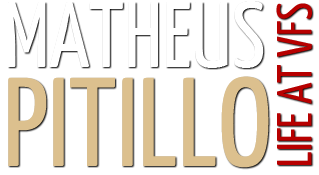
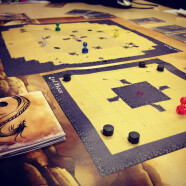











Bem da hora Matheus! Parabéns pelo joguitos!
Vaaaaleeeuu cara! Eu curti muito o resultado final tambem!
O jogo realmente parece ser bem interessante Matheus. Daqui alguns anos estarei jogando alguma nova versão do “Elder Scrolls” ou “Dark / Demon’s Souls” com toques de sua habilidade e criatividade. XD
Eu, a Dany e o Álvaro estamos torcendo por você.
Olha voce por aqui. AEEE! Quem dera eu consiga vaga em uma dessas empresas mesmo. HAHAHA. Eu conheci o Bruce Nesmith, Director of Design da serie Oblivion. Eu estou curtindo muito o curso. A escola eh sensacional e tudo por aqui tambem. Voces precisam vir logo me visitar. Espera o Alvaro nascer e venham. Valeu pelo comment, Gui! Manda um beijao pra Dany.
Eu estou curtindo muito o curso. A escola eh sensacional e tudo por aqui tambem. Voces precisam vir logo me visitar. Espera o Alvaro nascer e venham. Valeu pelo comment, Gui! Manda um beijao pra Dany.
Way to go little boy! So proud of you!
awesome summary and boardgame.
very good work dude! =)
Heeeey! Thanks, dude. I’m looking forward to see your board game project too.
Trabalho muito bem feito, criativo e fácil de entender.
Amei
Muito, muito obrigado pelo comentário, Ellen.
Great work!
THAAANKKKSS!!!